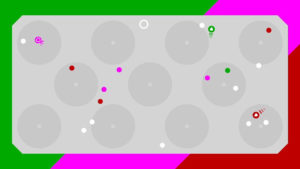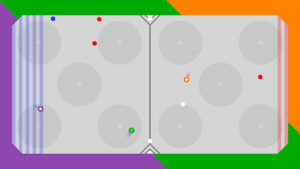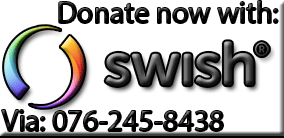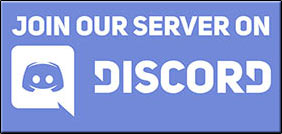12 Orbits Nintendo Switch review – A decent, fun and simple local multiplayer game

“12 Orbits” isn’t a type of game that I would normally grab to play, at least by the marketing video for the game. Their promotional video gives no real clues on to what the game is about, where it looks like a touch screen game. Where this just isn’t the case and brought about some confusion when the game was started up the first time. Anyways, enough about the marketing of “12 Orbits”. So let’s see how the game holds up shall we?
“12 Orbits” is a very simple concept of a game that brings to it a different kind of difficulty. You are in control of a single orb traveling across the screen controlled with the press of a single button. The direction that your orb travels are changed by using a center of gravity on a flat field. This same single button, when pressed outside of the center of gravity, it will make the orb spin and increase its speed momentarily.
The instructions of this one button, however, weren’t made clear on what button it is and combined with the bad marketing video it took a bunch of button mashing to figure out how to play the game properly. It is a very simple button, and I do feel dumb for not figuring it out faster than what I did. What button is used to control that orb? The same button that was pressed to make your character appear before the game started.
However, what is very strange is that multiple buttons can be used on each JoyCon. What I mean by this is that with each JoyCon, it can support up to eight players each. I do understand the thought process here, as the game was ported from Andriod/IOS and PC, where all twelve people can play by laying claim to a single button on the keyboard. Nevertheless, there is no way two people will be sharing a JoyCon let alone eight people.
There are four different game types to choose from, two that is in a free for all and four in a team setting that repeats the first two. These modes are titled Arena, Trails, Blizzard, and Multiball each with their own unique spin on what the end goal or how it is played. With all of them, the rules of the game are very easy to understand what you need to do, but how you do it is where all of the challenges really are.
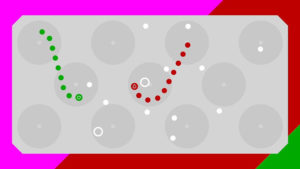
“12 orbits” is very easy to pick up and play. In other words, anyone should be able to getting going with the game in no time.
In the Arena game mode, there are several white balls that appear on the screen, when your orb hits one of the white ones, it changes the color to that of your character. This orb is now considered deadly to the other players where they need to try and avoid those while collecting other orbs.
However, what else shows up is a large circle outline and when that is hit it makes every orb in a radius change color to yours. This also applies to any orbs that are owned by your opponent, making it so how dangerous it is to move around the change in an instant. With Trails, the white orbs follow you around, so it becomes something like a multi-player version of snake.
This can make traveling around very difficult, using the one button for a speed increase does make it so you can travel through another snake and not die, but then if you are in a center of mass, yeah that ends badly. Like Arena, there is the same area of effect circles that can steal all of the orbs from the enemy snakes.
Furthermore, for one more added aspect to this mode is the one button when you get the speed boost you also shoot one of your orbs. When it is shot out, for a small amount of time if it hits another player at the head of the snake it will kill them if it misses the orb turns white once more.

“12 orbits” offers couch co-op up to 12 people and a very relaxing musical score, and that’s a really great combination I have to say (in my opinion).
Moving into the team-based game types where Blizzard is the first we talk about. The screen is a split into two where team one can only be on one side and so on. Two orbs move along the center line going up and down, where the point is to knock them into a goal zone on the other side. When an orb is hit, it changes color, so it is up to the other side to hit the orb that is heading into their end zone changing its color so that no points are scored.
When a point is scored the orb turns white once more, to add to this chaos is that every time an orb is hit from the center it is replaced making it to that there are many orbs bouncing around the place. Personally, while playing this map with three people, games often got as many as ten orbs bouncing all over the place.
Finally, there is Multiball where at the start of the game in the center of the field there are two orbs moving around an area of effect circle. It’s very simple really. You simply aim to bounce one of the orbs into a small goal on either side of the screen. You see, knocking an orb that is the same color as your goal will just make the orb disappear with no points attributed. Every time that an orb disappears, regardless of a point being scored or not, it will reappear as a white orb in the center of the screen.
The music in “12 Orbits” is light and blends into the background of the game. It easily fits the gameplay, airy and relaxing while trying to keep up with the chaos that will happen in a game. At times, the music isn’t all that noticeable while trying to just get your orb moving in the correct direction.
Pros:
+ Easy to pick up and play
+ Couch co-op up to 12 people
+ Relaxing musical score
Cons:
– Controls of the one button not described well
– No CPU for a single player mode
– Easy to accidentally add more players to the game
Gameplay: 3/5
Graphics: 3.5/5
Sound/music: 3.5/5
Controls: 3/5
Replay value: 4/5

Verdict: 3.5/5
12 Orbits is a really fun local multiplayer game, and it’s very simple to learn how to play. Figuring out the right timing to release from an orbit to move in the right direction, using a speed up to avoid danger, or thinking that you are going to boost only to orbit into danger is hard. More information on how to play would be greatly appreciated. Thinking that multiple people will use a JoyCon for a multiplayer game, is head scratching, but maybe you can pay attention to multiple orbs at once as for just you.
However, at the same time, 12 Orbits does add something different. It is a game that is different from most of the other games out there. Adding to this, I can only imagine the total chaos that would exist if you got 12 people in a single game regardless of game mode. So if you want to try something different give 12 Orbits a shot.
Title: 12 Orbits
Developer: Roman Uhlig
Format: Nintendo Switch
Genre: Party/Action/Arcade/Sports
Resolution: 720p to 1080p
Release date: 2018-04-27
Difficulty: Normal
Spent time: +10 hours
Average grade internationally: 60% Gamerankings.com
PEGI age rating: +6
Price: 1,99 USD via the Nintendo E-shop
Credit:
Robin Ek – Editor
***Disclosure***
The review code was provided by Roman Uhlig.
P Albert
The Gaming Ground
Twitter: @ThatDamnedGamer
More by Guest Author:
- Farming Simulator 25 mods – downloading, installing & more
- Here are the top five most popular games of 2024 you need to play
- The role of music and soundtracks in creating immersive gaming worlds
- FS25 is coming this Fall (2024) with a large selection of mods
- How technology and social media have influenced the gambling industry
Tags: 12 Orbits, Indie games, Nintendo Switch review, Party games, Roman Uhlig, Switch



